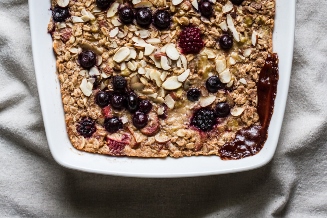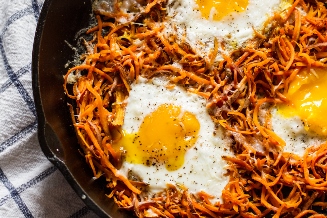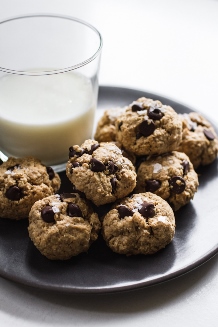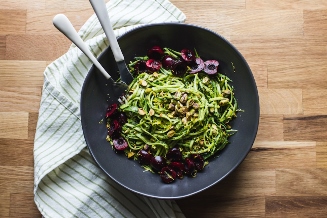Easy Cornbread Muffins
/I about lost my patience with these cornbread muffins. You wouldn’t think trying to come up with a simple muffin recipe could make you want to claw your eyes from your head.
Okay, slight exaggeration.
The only reason I kept going was because it was -30 outside and snowing.
As seen through the window.
Okay, it was more like 18, but it was 72 on Sunday so today felt like -30. I seriously could not warm up today, even while wearing wool socks, a scarf, and having the oven on 400° for over an hour.
And yes our heat is on. It’s very, very on.
Anyway. After a major baking battle I finally landed on these barely rounded, almond-flecked, honey-kissed beauties.
They’re everything I want in a cornbread muffin.
Light, fluffy, golden in color, and with a slight crumb.
Yes, I did just say these gluten-free cornbread muffins are light + fluffy. I speak the truth!
The muffins themselves are just barely sweetened but are always up for a little drizzle after baking.
You know, for good measure.
If you’re looking for a breakfast muffin, this is it.
If you’re looking for a bready Thanksgiving side, this is it.
If you’re looking for a snack…you see where I’m going with this.
Easy Cornbread Muffins
gluten-free // yields 12 muffins
- 1 cup fine ground cornmeal
- 1/2 cup millet flour
- 6 tablespoons almond meal
- 1 tablespoon baking powder
- 1/2 teaspoon salt
- 2 large eggs
- 1 cup unsweetened almond milk
- 3 tablespoons applesauce
- 4 tablespoons butter, melted
- 1/4 cup honey
Preheat your oven to 400° F. Line a muffin tin with 12 liners.
In a large bowl stir the cornmeal, millet flour, almond meal, baking powder, and salt together.
In another bowl whisk the eggs, milk, and applesauce. In a small bowl whisk the honey into the melted butter. Then pour the butter mixture into the egg mixture and whisk.
Pour the wet ingredients into the dry and whisk or stir together until you no longer see dry flour. Let the mixture sit undisturbed for 5-8 minutes.
Scoop even amounts into the muffin liners and place in the oven to bake for 15-18 minutes, until a toothpick feels just moist to the touch.
Let cool for 10-15 minutes then serve plain or with butter and honey.
Notes: I highly recommend not making any substitutions to the flours. If you can’t fine finely ground cornmeal, grind some in your blender until softer in texture. Millet flour can easily be ground from whole millet in a blender, coffee grinder, etc. until soft and flour-like.
My favorite thing to do is warm these little guys (or any cornbread) in a skillet with a dab of ghee and eat alongside a pile of eggs. That will be happening ASAP.
Enjoy!
Ashley









![The Best Gluten-Free Pizza [& vegan!] | edibleperspective.com #vegan #glutenfree](https://images.squarespace-cdn.com/content/v1/546ab118e4b020f024f62077/1425342761911-PQ56LN734DYK6TAB2XNB/Windows-Live-Writer-5fb93e236023_6BA9-)
![The Best Gluten-Free Pizza [& vegan!] | edibleperspective.com #vegan #glutenfree](https://images.squarespace-cdn.com/content/v1/546ab118e4b020f024f62077/1425342762111-DAG21566KKJWCIJWK73R/Windows-Live-Writer-5fb93e236023_6BA9-)
![The Best Gluten-Free Pizza [& vegan!] | edibleperspective.com #vegan #glutenfree](https://images.squarespace-cdn.com/content/v1/546ab118e4b020f024f62077/1425342762316-1DACE8AE5IOB4YK16NVS/Windows-Live-Writer-5fb93e236023_6BA9-)
![The Best Gluten-Free Pizza [& vegan!] | edibleperspective.com #vegan #glutenfree](https://images.squarespace-cdn.com/content/v1/546ab118e4b020f024f62077/1425342762514-3PYHL2VF44G1O4LBLMCS/Windows-Live-Writer-5fb93e236023_6BA9-)
![The Best Gluten-Free Pizza [& vegan!] | edibleperspective.com #vegan #glutenfree](https://images.squarespace-cdn.com/content/v1/546ab118e4b020f024f62077/1425342762764-CTD84R8QUMP7F4UGEJ2S/Windows-Live-Writer-5fb93e236023_6BA9-)
![The Best Gluten-Free Pizza [& vegan!] | edibleperspective.com #vegan #glutenfree](https://images.squarespace-cdn.com/content/v1/546ab118e4b020f024f62077/1425342762914-S5QC50KZ9YJFHMX74HVB/Windows-Live-Writer-5fb93e236023_6BA9-)
![The Best Gluten-Free Pizza [& vegan!] | edibleperspective.com #vegan #glutenfree](https://images.squarespace-cdn.com/content/v1/546ab118e4b020f024f62077/1425342763116-93BW5TM66OYTQEMN789P/Windows-Live-Writer-5fb93e236023_6BA9-)
![The Best Gluten-Free Pizza [& vegan!] | edibleperspective.com #vegan #glutenfree](https://images.squarespace-cdn.com/content/v1/546ab118e4b020f024f62077/1425342763323-4FSWZBLM3G3LS9FJKMCS/Windows-Live-Writer-5fb93e236023_6BA9-)
![The Best Gluten-Free Pizza [& vegan!] | edibleperspective.com #vegan #glutenfree](https://images.squarespace-cdn.com/content/v1/546ab118e4b020f024f62077/1425342763523-P66L4YOXXJBAJRBLWM1D/Windows-Live-Writer-5fb93e236023_6BA9-)
![The Best Gluten-Free Pizza [& vegan!] | edibleperspective.com #vegan #glutenfree](https://images.squarespace-cdn.com/content/v1/546ab118e4b020f024f62077/1425342763753-8JTX6QZYOH6BYD6VBIZ1/Windows-Live-Writer-5fb93e236023_6BA9-)
![The Best Gluten-Free Pizza [& vegan!] | edibleperspective.com #vegan #glutenfree](https://images.squarespace-cdn.com/content/v1/546ab118e4b020f024f62077/1425342763919-OT262SRZMNGGGQY1L94L/Windows-Live-Writer-5fb93e236023_6BA9-)














